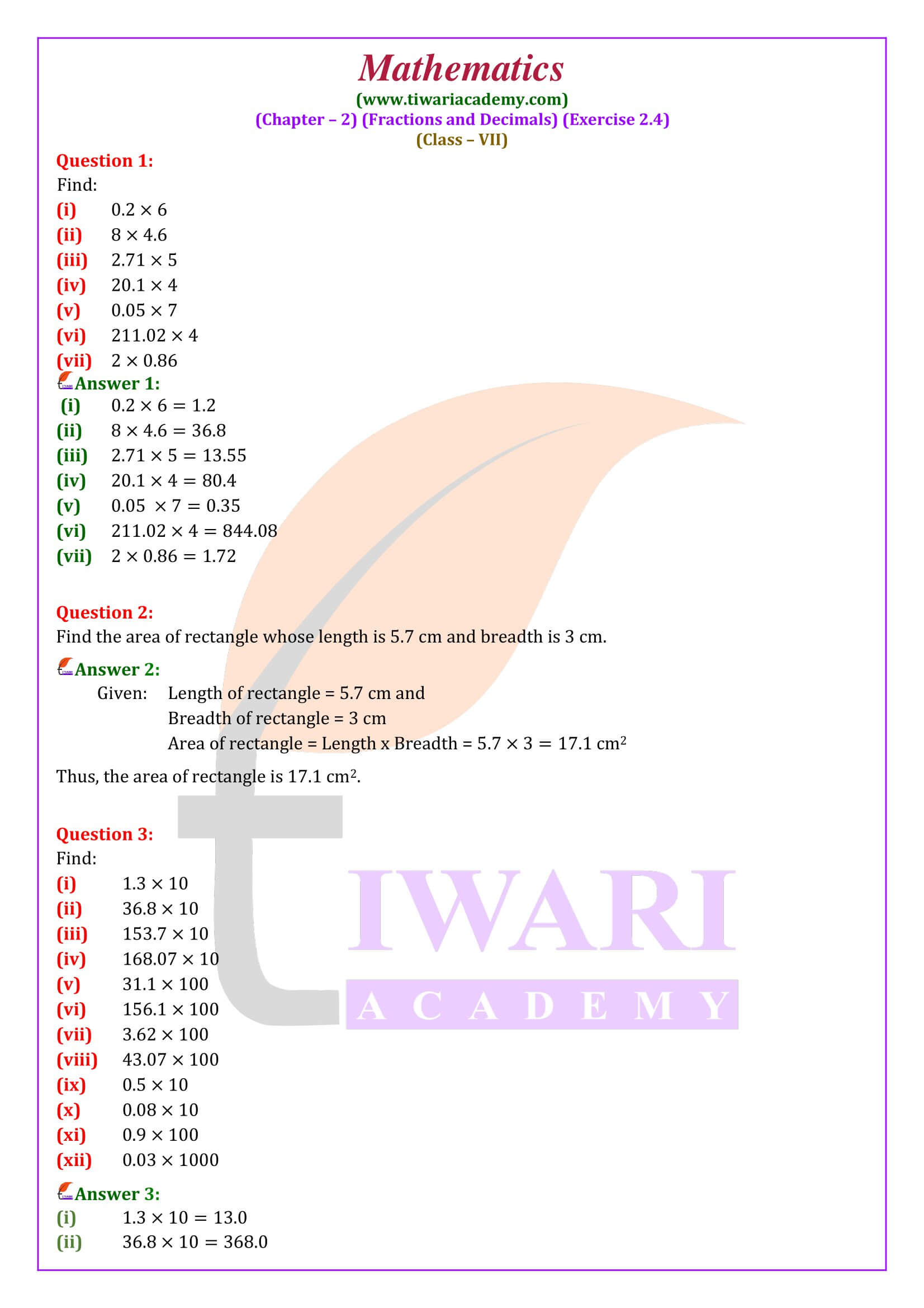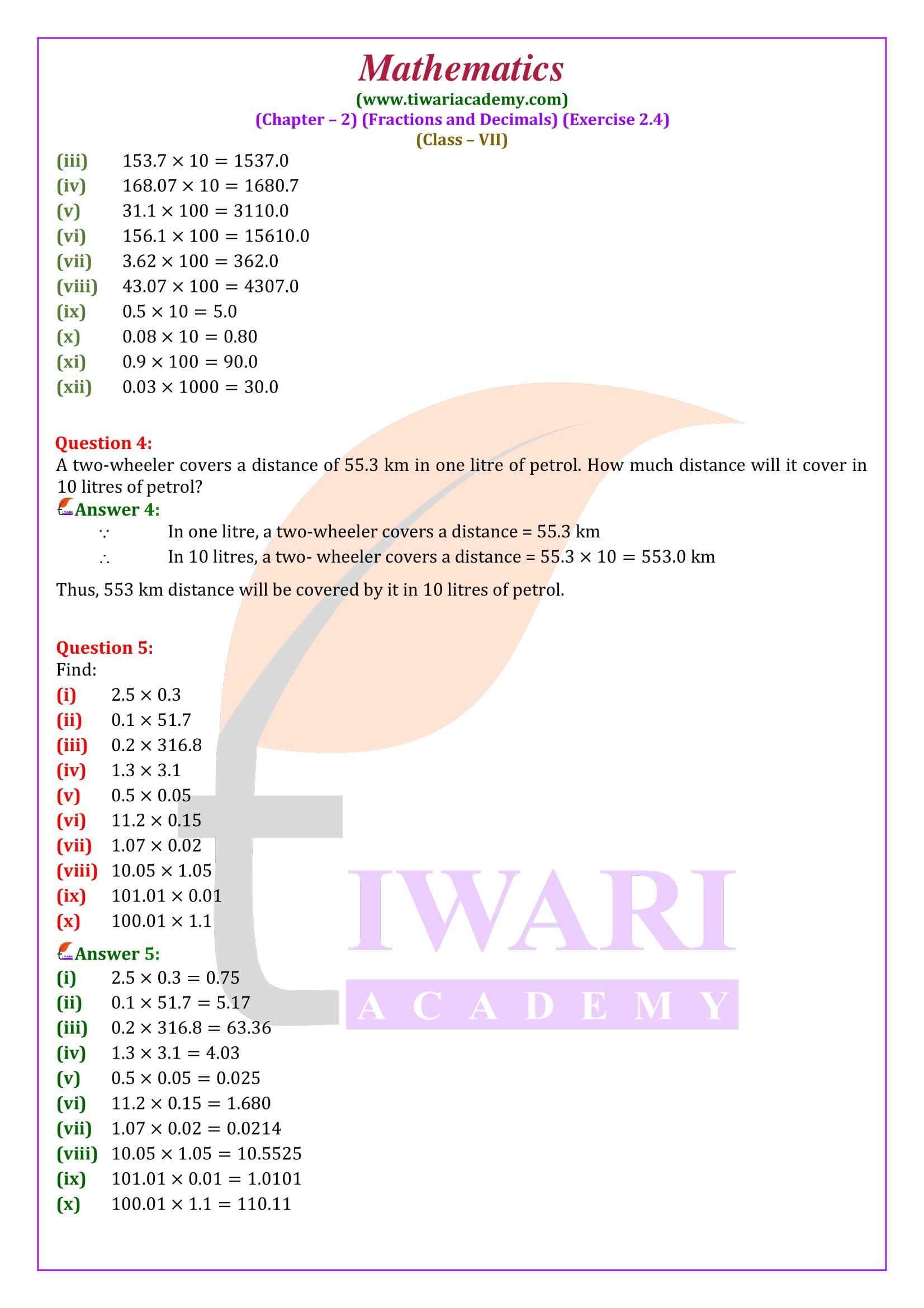NCERT Solutions for Class 7 Maths Chapter 2 Exercise 2.4 Updated for New Session 2025-26 Fractions and Decimals in Hindi and English medium. The explanation of questions are updated according to new syllabus and latest textbooks published for session 2025-26 exams.
NCERT Solutions for Class 7 Maths Exercise 2.4 in Hindi and English Medium
| Class: 7 | Mathematics |
| Chapter: 2 | Exercise: 2.4 |
| Chapter Name: | Fractions and Decimals |
| Content Mode: | Text, Videos and PDF |
| Session: | Academic Year 2025-26 |
| Medium: | Hindi and English Medium |
Class 7 Maths Chapter 2 Exercise 2.4 Solution
All the contents and solution are updated on the basis of latest CBSE Books issued on 2025-26. In class 7 Maths exercise 2.4 all the questions are based on multiplication of decimal numbers. Word problems given at the end of exercise also focused on multiplication of decimals.
Class 7 Maths Exercise 2.4 Extra Questions
Convert each of the following decimals into a fraction in its simplest form: (i) 0.5 (ii) 0.24 (iii) 0.08 (iv) 0.225
We have:
(i) 0.5 = 5/10 = 1/2
(ii) 0.24 = 24/100 = 6/25
(iii) 0.08 = 8/100 = 2/25
(iv) 0.225 = 225/1000 = 9/40
Convert each of the following into a decimal fraction. (i) 27/4 (ii) 2(5/8)
On dividing, we get:
(i) 27/4
(27.00)/4 = 6.75
(ii) 2(5/8) = 21/8 = (21.0000)/8 = 2.625
Add 36.4, 273.06, 9.397 and 68.
Converting the given decimals into like decimals, we get:
36.400, 273.060, 9.397 and 68.000.
Writing these decimals in column form and adding, we get:
36.400
273.060
9.397
68.000
386.857
Hence, the sum of the given decimals is 386.857.
Subtract 47.56 from 83.2.
Converting the given decimals into like decimals, we get 47. 56 and 83.20. Writing them in column form with the larger one at the top and subtracting, we get:
83. 20
– 47.56
35.64
Hence, (83.20 – 47.56) = 35.64.
Method of Converting a Decimal into a Fraction
The steps to convert decimal number into fraction:
Step 1. Write the given decimal without the decimal point as the numerator of the fraction.
Step 2. In the denominator, write 1 followed by as many zeros as there are decimal places in the given decimal.
Step 3. Reduce the above fraction to the simplest form.
Class 7 Maths Exercise 2.4 Important Questions
What is important to remember when adding and subtracting decimals?
The most important thing to remember when adding and subtracting decimals is lining up the decimal point. And making sure when you regroup you add the number and add it to the original total.
How do you add a decimal to a whole number?
To add decimal numbers:
(i) Put the numbers in a vertical column, aligning the decimal points.
(ii) Add each column of digits, starting on the right and working left.
(iii) Place the decimal point in the answer directly below the decimal points in the terms.
How do you write a decimal in words?
To write a decimal in word form, follow these steps:
(i) Let’s try it with 2.37.
(ii)First, write the whole-number part.
(iii) Write “and” for the decimal point.
(iv) Next, write the word form of the digits in the decimal part.
(v) Finally, end with the place value of the last digit.
Converting a Fraction into a Decimal in Class 7 Maths Exercise 2.4
The steps to convert a fractional number into decimal:
Step 1. Divide the numerator by the denominator till a nonzero remainder is obtained.
Step 2. Put a decimal point in the dividend as well as the quotient.
Step 3. Put a zero on the right of the decimal point in the dividend as well as on the right of the remainder.
Step 4. Divide again just as we do in whole numbers.
Step 5. Repeat steps 3 and 4, till the remainder is zero.
7th Maths Exercise 2.4: Addition and Subtraction of Decimals
Addition of Decimals in Class 7 Maths Chapter 2 Exercise 2.4
The steps to add decimal numbers:
Step 1. Convert the given decimals into like decimals.
Step 2. Write the addends one under the other in column form, keeping the decimal points of all the addends in the same column and the digits of the same place in the same column.
Step 3. Add as in the case of whole numbers.
Step 4. In the sum, put the decimal point directly under decimal points in the addends.
Class 7 Maths Chapter 2 Exercise 2.4: Subtraction of Decimals
The steps to subtract decimal numbers:
Step 1. Convert the given decimals into like decimals.
Step 2. Write the smaller number under the larger one in column form in such a way that the decimal points of both the numbers are in the same column and the digits of the same place lie in the same column.
Step 3. Subtract as we do in case of whole numbers.
Step 4. In the difference, put the decimal point directly under the decimal points of the given numbers.
Are there any examples in exercise 2.4 of class 7th Maths?
Yes, there are two examples in exercise 2.4 of class 7th Maths. In example 7, the side of an equilateral triangle is given and students have to find out the perimeter of an equilateral triangle. In example 8, the length and breadth of a rectangle are given and students have to find out the area of a rectangle.
How many days are needed to complete exercise 2.4 of class 7th Maths?
Students need at most 2-3 days to complete exercise 2.4 of class 7th Maths if they give 1 hour per day to this exercise. This time is an approximate time and can vary.
Which questions of exercise 2.4 of class 7th Maths can students expect for the exams?
In exercise 2.4 of class 7th Maths, There are 2 examples (examples 7, 8) and 5 questions. Question 1 has 7 parts, question 3 has 12 parts, and question 5 has 10 parts. All the questions and examples of this exercise are the most important. Any problem of this exercise can come in the exams.
Is exercise 2.4 of grade 7th Maths easy to solve?
Exercise 2.4 of grade 7th Maths is not at all challenging. This exercise is overall a simple exercise. However, the difficulty level of any exercise depends on students also. Some students find exercise 2.4 easy, and some students find exercise 2.6 difficult.






